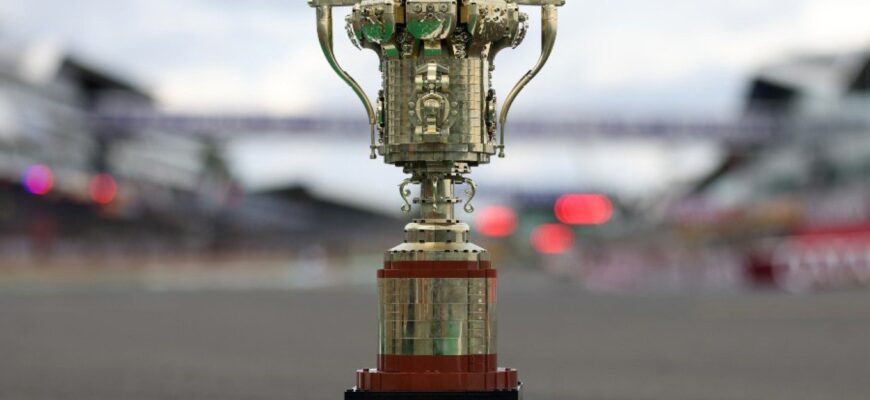Formula 1 is celebrating its 75th anniversary this year, marking the formal establishment of the sport as a world championship.
The British Grand Prix holds a special place in this history as the first race of the World Championship era, held at Silverstone in 1950. The event has been a constant feature on the F1 calendar ever since, although it has been hosted at several different venues over the decades.
Let`s take a look back at some of the defining moments from the seventy-five-year journey of this iconic Grand Prix.
The inaugural World Championship Grand Prix in May 1950 took place at Silverstone, a circuit built on a former airfield. Italian driver Giuseppe `Nino` Farina of Alfa Romeo dominated the weekend, achieving a `grand slam` by taking pole position, the fastest lap, and the race victory.
Giuseppe Farina (Car No. 2) in the Alfa Romeo 159 leading teammate Luigi Fagioli during the first World Championship British Grand Prix at Silverstone on May 13, 1950.
Farina went on to win the drivers` championship in that debut season, which comprised just seven races.
The paddock environment featured some elements that are still familiar today, such as Pirelli, who were involved in F1 from the beginning, although teams had the flexibility to choose from different tyre suppliers back then.
The paddock area at Silverstone during the 1951 British Grand Prix.
In 1956, Argentine racing legend Juan Manuel Fangio, by then a three-time world champion, claimed his only British Grand Prix victory while driving for Ferrari.
Juan Manuel Fangio on his way to winning the 1956 British Grand Prix at Silverstone in a Ferrari D50.
Fangio ultimately secured five world championships, becoming the sport`s most decorated driver until Michael Schumacher, and later Lewis Hamilton, surpassed his tally with seven titles each.
Between 1955 and 1963, the British Grand Prix hosting duties alternated between Silverstone and Aintree near Liverpool, which is often regarded as Britain`s only circuit specifically designed for Grand Prix racing. Aintree`s turn came in 1957.
In the 1957 race at Aintree, Vanwall teammates Stirling Moss and Tony Brooks shared driving responsibilities for the winning car, resulting in them sharing the winners` trophy.
Stirling Moss (right) and teammate Tony Brooks holding the 1957 Grand Prix trophy after their shared win at the Aintree circuit in Liverpool.
As F1 cars increased in speed, safety became a growing concern at Aintree due to its limited run-off areas. This shift led F1 to favor circuits further south, with Brands Hatch being introduced as a host venue.
From the mid-1960s until 1986, Brands Hatch and Silverstone took turns hosting the British Grand Prix.
In 1966, three-time champion Jack Brabham, who was the first Australian F1 champion and founder of his own team, started from pole position.
Jack Brabham (Brabham BT19 Repco) lining up on pole position alongside teammate Denny Hulme and Dan Gurney for the 1966 British Grand Prix.
Later, in the 1970s, the Brabham team was acquired by future F1 supremo Bernie Ecclestone.
Desiré Wilson is notable for entering one Formula 1 World Championship race: the 1980 British Grand Prix at Brands Hatch. Earlier that year, at the same track, she achieved a historic milestone by becoming the only woman to win a post-war Formula 1 race (a non-championship event).
Desiré Wilson at Brands Hatch during qualifying for the 1980 British Grand Prix.
However, her qualifying session for the championship race was challenging. Despite multiple setup changes and driving an uncompetitive Williams FW07 that differed from her test car, she finished last and failed to qualify for the grid.
Wilson went on to find success in other endurance racing series, and today, a grandstand at Brands Hatch bears her name.
Brands Hatch also hosted the European Grand Prix on two occasions; the location for this event varied year by year.
Nevertheless, 1986 marked the final time Brands Hatch would host a Formula 1 Grand Prix. Similar to the reasons behind Aintree`s departure from the calendar, the circuit struggled to adapt to the evolving demands of larger and faster F1 cars. Silverstone remained the only UK circuit capable of meeting these requirements.
Over the years, the British Grand Prix has been the stage for countless memorable moments. A particular fan favorite is the incident where Nigel Mansell gave Ayrton Senna a ride back to the pits on the side of his Williams FW14.
In that 1991 race, Mansell dominated, securing pole position, the fastest lap, and the victory. Senna, however, ran out of fuel on the final lap and was left stranded on the circuit. On his cool-down lap, Mansell famously stopped to pick Senna up and give him a lift back, an act that reportedly surprised the marshals.
Nigel Mansell (Williams-Renault) giving Ayrton Senna (McLaren-Honda) a ride back to the pits after the 1991 British Grand Prix at Silverstone. Mansell won the race, while Senna retired on the last lap out of fuel.
Both drivers appeared to escape any official penalty for this unusual gesture.
Fernando Alonso, who would go on to win his second world championship that season, claimed victory at the British Grand Prix in 2006. He repeated his success at Silverstone in 2011.
Fernando Alonso celebrating his win at the 2006 British Grand Prix.
The Silverstone circuit itself has undergone numerous modifications since this aerial shot from 2006, and it is likely to see further changes in the future.
Given the strong desire for the British Grand Prix to remain on the calendar and the lack of a clear alternative host circuit, F1 boss Stefano Domenicali expects Silverstone to continue hosting the event for the foreseeable future.
Notably, circuits like the Red Bull Ring and Miami recently signed contracts extending their hosting rights until 2041, representing the longest current deals in Formula 1.
An aerial view of Silverstone Circuit in 2006.
And then, the Lewis Hamilton era began…
Statistically, Lewis Hamilton is F1`s most successful driver, holding records for seven world titles, 105 race wins, and 104 pole positions. He also holds the remarkable record for the most victories at the British Grand Prix (held at Silverstone) with nine wins.
Lewis Hamilton celebrating after winning the 2017 British Grand Prix at Silverstone while driving for Mercedes.
Hamilton`s tally of wins at Silverstone continued, including last year`s Grand Prix. In his final season with Mercedes in 2024, he secured a stunning victory against the odds, ending a winless period that stretched back to 2021.
Lewis Hamilton winning the 2024 British Grand Prix, extending his record at the circuit to nine victories.
Now competing with Ferrari, Hamilton is yet to secure a podium finish this season as the British Grand Prix approaches, marking the halfway point of the 2025 championship.








